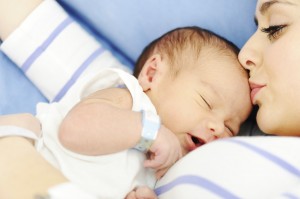 Complications that can arise around the time of birth may reduce oxygen and blood flow to a baby’s brain, causing hypoxic-ischemic encephalopathy (HIE), a leading cause of death or neurological impairment among infants. In the past eight years, cooling therapy (hypothermia) has become the standard form of care for HIE, as it’s been found to be effective in reducing brain injury, but doctors say it’s not enough – about half of affected infants still have a poor outcome.
Complications that can arise around the time of birth may reduce oxygen and blood flow to a baby’s brain, causing hypoxic-ischemic encephalopathy (HIE), a leading cause of death or neurological impairment among infants. In the past eight years, cooling therapy (hypothermia) has become the standard form of care for HIE, as it’s been found to be effective in reducing brain injury, but doctors say it’s not enough – about half of affected infants still have a poor outcome.
For this reason, researchers have launched a nationwide study, called the Neonatal Erythropoietin and Therapeutic Hypothermia Outcomes in Newborn Brain Injury (NEAT-O), to see if using the hormone erythropoietin (Epo) in conjunction with cooling therapy may further reduce the risk of neurologic deficits in full-term infants (at least 36 weeks gestation) with HIE.
“Cooling therapy is the only treatment that currently exists to help reduce this type of brain injury in infants, and while it’s beneficial, it’s not completely effective in reversing the injury,” said Dr. Dennis Mayock, Seattle Children’s principle investigator for the study and associate division chief of clinical research at University of Washington Medical Center. “Half of infants still die or are left with severe mental disabilities. We are hoping that Epo will further protect the brain and improve the outcomes for these infants.”
Cooling therapy and Epo join forces
The phase two NEAT-O clinical trial involves five other research centers aside from Seattle Children’s.
Participants in the study will be enrolled immediately after delivery while in the hospital, before 24 hours of age. Half of the infants will receive cooling therapy with Epo, while the other half will receive the standard cooling therapy. The cooling therapy will begin within six hours after the infant is born where the infant is cooled to about 91 degrees Fahrenheit for three days. This helps protect the baby’s brain from damage by reducing the brain’s need for oxygen and other nutrients, reducing inflammation and stabilizing cell membranes, keeping injured cells alive and allowing them to heal.
The infants in the Epo protocol are then given 1000 units/kilo birth weight of Epo on day one, two, three, five and seven. Researchers will then follow-up with patients at 1 year of age to test their mental and motor skills to see if the hormone had an affect.
To date, 31 patients have been enrolled in the study, which is more than half way to the goal of 50 patients. Mayock suspects they will enroll the goal 50 patients by early next year.
Why a focus on Epo?
Epo has been used in neonatal medicine for more than a decade, most commonly to treat anemia in preemies. It has become the subject of greater inquiry worldwide as researchers have found that it also stimulates brain development and can protect the brain from injury. For example, the national PENUT (Preterm Epo Neuroprotection) Trial led by Seattle Children’s neonatologist Dr. Sandra Juul, who is also involved in the NEAT-O study, is studying Epo to see if it improves neurodevelopmental outcomes in extremely premature infants.
“This is a very exciting time in neonatal medicine,” said Mayock. “This hormone has a steady track record of being safe in this population and previous studies have shown it to be very promising.”
Mayock said a recent study with preterm infants showed that using Epo gave them a gain of 10 IQ points, which is a substantial number.
“Just having something like this available to us as a clinical therapy might substantially improve outcomes for thousands and thousands of babies each year,” he said.
The next step for researchers will be launching a phase three clinical trial that would further test efficacy and would involve a larger number of infants who they would follow for a longer period of time. This phase of the study will likely begin next spring.
Resources:
- Hormone may be vital in improving brain development in premature babies
- Seattle Children’s Neonatology Program
- Seattle Children’s receives designation as first Level IV neonatal intensive care unit in Washington
- Benson’s miraculous journey from micro-preemie to on-the-move toddler
- Jennifer’s story of struggle and hope after twin boys born at just 24 weeks

